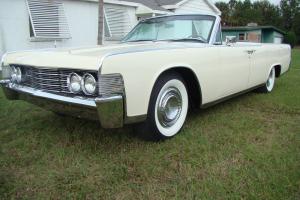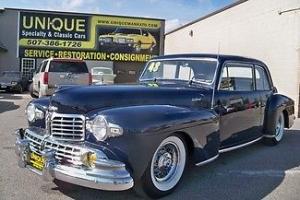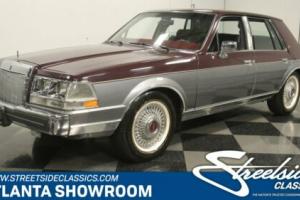Classic Cars / Lincoln / Car for sale
1936 Lincoln K Convertible Victoria by Brunn
Sale price: $165,000.00 make an offer
Car location: Indianapolis, Indiana, United States
Sale type: Fixed price listing
Technical specifications, photos and description:
- Got questions?
- Ask here!
1936 Lincoln K Convertible Victoria by Brunn for sale
Current customer rating:Lincoln is an American luxury car manufacturer, operated under the Ford Motor Company. Founded in 1917 by Henry M. Leland and acquired by Ford in 1922, Lincoln has been manufacturing vehicles intended for the upscale markets since the 1920s. Leland named the brand after his longtime hero Abraham Lincoln, for whom he had voted in the first presidential elections for which he was eligible
The company was founded in August 1917 by Henry M. Leland, one of the founders of Cadillac (originally the Henry Ford Company). He left the Cadillac division of General Motors during World War I and formed the Lincoln Motor Company to build Liberty aircraft engines with his son Wilfred. After the war, the company's factories were retooled to manufacture luxury automobiles.
The company encountered severe financial troubles during the transition, coupled with body styling that wasn't comparable to other luxury makers, and after having produced only 150 cars in 1922, was forced into bankruptcy and sold for USD $8,000,000 to the Ford Motor Comany on February 4 1922, which went to pay off some of the creditors. The purchase of Lincoln was a personal triumph for Henry Ford, who had been forced out of his second (after Detroit Automobile Company) company by a group of investors led by Leland. Ford's company, renamed Cadillac in 1902 and purchased by rival General Motors in 1909, was Lincoln's chief competitor. Lincoln quickly became one of America's top selling luxury brands alongside Cadillac and Packard. Ford made no immediate change, either in the chassis or the V-8 L-head engine which was rated 36.4 SAE and produced 90 bhp (67 kW/91 PS) at 2,800 rpm. An unusual feature of this power unit was the 60 degree separation of the cylinder blocks that helped to cut down on synchronous vibration found with similar engines with 90 degree separation produced at the time. After the Ford takeover, bodywork changes and reduced prices increased sales to 5,512 vehicles from March to December of 1922.
In 1923, several body styles were introduced, that included two- and three-window, four door sedans and a phaeton that accommodated four passengers. They also offered a two passenger roadster and a seven passenger touring sedan and limousine, which was sold for $5,200. A sedan, limo, cabriolet and town car were also offered by coachbuilders Fleetwood, and a second cabriolet was offered by coachbuilder Brunn. Prices for the vehicles built by these coachbuilders went for as much as $7,200, and despite the limited market appeal, Lincoln sales rose about 45 percent to produce 7,875 cars and the company was operating at a profit by the end of 1923.
1924 saw the introduction of large touring sedans used by police departments around the country. They were known as Police Flyers, which were equipped with four wheel brakes, two years before they were introduced on private sale vehicles. These specially equipped vehicles, with bullet proof windshields measuring 7/8 of an inch thick and spot lights mounted on the ends of the windshield, also came with an automatic windshield wiper for the driver and a hand operated wiper for the front passenger. Police whistles were coupled to the exhaust system and gun racks were also fitted to these vehicles.
Optional equipment wasn't necessarily an issue with Lincolns sold during the 1920s, however, customers who wanted special items were accommodated. A nickel plated radiator shell could be installed for $25, varnished natural wood wheels were $15, or Rudge-Whitworth center-lock wire wheels for another $100. Disteel steel disc wheels were also available for $60. Lincoln chose not to make yearly model changes, used as a marketing tool of the time, designed to lure new customers. Lincoln customers of the time were known to purchase more than one Lincoln with different bodywork, so changing the vehicle yearly was not done to accommodate their customer base. In 1927, Lincoln adopted the greyhound as their emblem, which was later replaced with diamond that is currently in use.
In 1932, Lincoln introduced the V12-powered KB. The same year, Eugene T. "Bob" Gregorie (1908-2002), at the styling studio created by Edsel Ford, began designing what became the Continental, eventually the most important car made by Lincoln. It started as a one-off project car for Edsel, who wanted a European-style car unlike the boxier designs his father's company produced, to drive around on vacations in Florida.
This Rare Model K Convertible Victoria is in excellent condition throughout having been the subject of a ground up restoration performed to a very high standard. The car has been used sparingly since the restoration and remains in Show Quality condition. The car runs and drives without falut with brisk acceleration, tight steering, and sure footed brakes.
This is a rare opportunity to own a coachbuilt Convertible Victoria one of the most desirable body styles of the Classic Era on the Full Classic Lincoln Chassis with the legendary K v12-arguably one of the Finest Chassis of the Classic Era .
This is a very rare car and will make welcome appearances at the most exclusive Concours while also being a great road car for the Touring enthusiast.
Dealer's Information2225 E 54th St,Indianapolis, IN, 46220, US(800) 837-9902[email protected]View our other auctionsEmail to friendAlso published at eBay.com
Want to buy this car?
Comments and questions to the seller:
Other classic Lincoln cars offered via internet auctions:
 price: $20,100.00Lincoln : Continental convertible
price: $20,100.00Lincoln : Continental convertible price: $48,705.001956 CONTINENTAL MARK II 2-DOOR HARDTOP, FACTORY A/C,RESTORED!!
price: $48,705.001956 CONTINENTAL MARK II 2-DOOR HARDTOP, FACTORY A/C,RESTORED!! price: $13,827.001948 Lincoln Mark I! TRADES/OFFERS
price: $13,827.001948 Lincoln Mark I! TRADES/OFFERS price: $10,000.001984 Lincoln Continental Valentino
price: $10,000.001984 Lincoln Continental Valentino
Latest arrivals:
-
$129,000.000
-
$10,000.000
-
$6,000.000
-
$7,100.000
-
$9,000.000
-
$10,000.000
-
$26,100.000
-
$8,100.000
-
$10,100.000
-
$87,995.000
-
$39,950.000
-
$13,500.000
-
$54,900.000
-
$27,000.000
-
$17,900.000
-
$12,300.000
-
$12,993.000
-
$14,900.000
-
$14,000.000
-
$6,800.000





















